2010 - Accident Reports
Mountain safety
The accidents described in the following reports represent the facts of individual events that occurred in the Mountain National Parks. They are provided for visitors to this website to gain knowledge from other people’s mistakes and unfortunate mishaps.
Most recent first
December
Trapped Under Ice, Johnston's Canyon, Banff National Park, December 13th, 2010November:
Injured Hiker, Lake Agnes Trail, Banff National Park, Nov 10, 2010August:
Leader Fall, Dan's Delight, Banff National Park, Aug 28, 2010 William Holland, Slipstream, Jasper National Park, Aug 15, 2010 Stranded Scrambler, Rockbound Lake, Banff National Park, Aug 23, 2010 Stranded Scramblers, Mt. Rundle, Banff National Park, Aug 23, 2010 Stranded Scramblers, Devils Thumb, Banff National Park, Aug 7th, 2010 Stranded Climbers, NW Ridge of Mt Sir Donald, Glacier National Park Aug 6, 2010 Stranded Scramblers, Mt. St. Piran, Aug 6th, 2010 Slip On Snow, Mt. Robson, Robson Provincial Park, Aug 2, 2010July:
Fall While Scrambling, Mt. Norquay, Banff National Park, July 30, 2010 Stranded Climbers, Lake Louise, Banff National Park, July 21, 2010 Stranded Scramblers, Cascade Amphitheatre, Banff National Park, July 21, 2010 Leader fall, Mt. MacDonald, Glacier National Park, July 7, 2010June:
Fall Off Cliff, Mt. St. Piran, Banff National Park, June 24 2010 Fall off Cliff, Peyto Lookout, Banff National Park, June 20, 2010May:
Uncontrolled Glissade, Whistler Mountain, Jasper National Park, May 1, 2010March:
Leader Fall, North Face of Mount Temple, Banff National Park, March 25, 2010 Cornice Collapse, Ursus Minor, Glacier National Park, March 7, 2010February:
Substantial Leader Fall, Cascade Waterfall, Banff National Park, Feb 13, 2010
Trapped Under Ice, Johnston’s Canyon, Banff National Park, December 13th, 2010
A solo canyon walker/ ice climber decided to travel on the ice below the main hiking trail at Johnston’s Canyon. He was equipped with crampons and an ice axe. He entered the canyon proper about 300m up the trail from the parking area. From here, he had to make many very delicate crossings, back and forth across the creek to make upward progress. After approximately 400m of travel on the ice in the canyon bottom, he broke through and managed to cling to the side of the hole that he fell through. The swiftness of the water underneath was dragging him down, and eventually he could hold on no further. He was washed under the ice and managed to stop approximately 10m downstream from where he fell in. There was an open cave feature that had an air pocket between the ice and the water, and there was just enough room for him to remain in a crouching position. He was submerged in water up to his waist.
While inside the ice cave he was trying to smash through the ice with his helmet, as he had lost his ice axe during the initial swim. His efforts to break through to the surface were fruitless and he was faced with a grave decision. He remembered seeing an opening in the creek, (when he was on the surface), approximately 15m further downstream from the small cave that he was in. He made the decision to continue downstream, under the ice, in hope that he would surface at the opening. This decision saved his life. He continued downstream in what was described as even more dubious, (less air, more water, and rough terrain on creek bottom), and managed to surface at the opening he had remembered seeing.
Bystanders recalled seeing and hearing a man trapped under the ice. This was likely when he was trying to break through to the surface from the small ice cave he was trapped in. They notified Visitor Safety Specialists through Banff Dispatch. A few minutes later the same bystanders witnessed the man emerge from the opening in the creek. The subject was on the ice in the canyon below the trail, still partly submerged in the water. Three of the bystanders took action and rigged a tow rope with a dog leash that was attached to a tree branch. This enchainment of items was long enough to reach the subject approximately 10m from the guardrail on the trail. They were able to assist the man onto the trail using this system. They placed warm jackets on top of the subject and waited for Visitor Safety Specialists to arrive. Seven VS specialists arrived with a wheeled stretcher, sleeping bag, and heat packs soon after the man was brought up from the canyon. The subject was packaged and wheeled to Banff EMS at the trail head.

The red circle indicates where the subject fell through the ice. He re-surfaced 25m downstream.
© Parks Canada
Analysis
The subject was extremely lucky to live. In most cases, situations like this end up in a recovery effort. When walking on ice over moving or still water, park users need to be 99.9% confident with the surface they are walking on. On a still lake 8cm is the minimum amount of ice, but with moving water there are so many variables that a wider margin is recommended. Travelling in pairs also reduces vulnerability, and is recommended. There was a second component to this situation that is worthy of discussion. The bystanders at the scene played a key role in saving this man’s life. It is a very tough judgment call to make whether to help someone in a perilous situation like this, given there are many potential risks to would be spontaneous rescuers.
The mountain parks have a professional 24/7 backcountry response team that is prepared for all of these situations. If park visitors encounter such situations, they should only provide assistance if they feel they can safely do so, and if the subject in need is in a “LIFE OR DEATH SITUATION”. If there is any question or if the situation is NOT life or death, it is advised to wait for Visitor Safety Specialists to arrive as the situation could be much worse if the subsequent bystanders need rescuing also
Injured Hiker, Lake Agnes Trail, Banff National Park, Nov 10, 2010
A lone Texan hiker ascended to Lake Agnes via the very popular hiking trail. There was very little snow on the ground around Lake Louise and in the surrounding area. However, there was snow on the trails leading to Lake Agnes.As the hiker descended back down to the Chateau, he slipped backwards and heard a loud “pop” from his left leg. Worried that he had broken his leg, the hiker stopped where he was and called for emergency services to help him down the trail. He also called a friend to come and help him.
The initial report that came to Banff Dispatch was of a man in his late 50’s with a broken leg, somewhere above Lake Louise. The call was transferred to a Visitor Safety (VS) Specialist who gathered information as to the whereabouts of the injured hiker. This information was then transferred to a local VS Specialist who hiked up the trail to locate the injured man. The hiker was assessed and treated for a knee injury, his leg splinted and immobilized. It was determined that trying to place the patient on a stretcher and walking him out would be too treacherous with the very slippery trail conditions. While the hiker was being treated, a VS team was preparing to sling into the location by helicopter. The trail is heavily forested by trees that are 100+ feet in height. The VS team was inserted into the trail, where the patient was then placed into a Baumann Bag (for slinging a horizontal patient on a spine board), then flown out to the parking area. The patient was then transferred to Banff EMS.
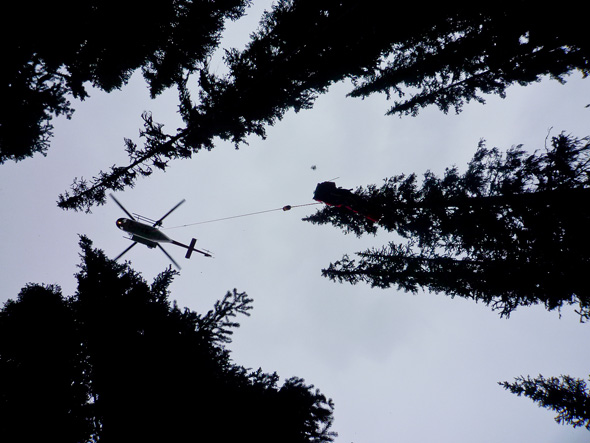
Helicopter/© Parks Canada
Analysis
Although there was very little snow on the ground, there was enough on the shaded trail that after several hundred people had trodden on it, it became a very slick surface where poorly treaded shoes held little purchase. It is much easier to hike up a slick surface than down, as you are moving slower against gravity. However, as the hiker descended, he built up too much speed and fell awkwardly, tearing his patellar tendon. Hiking on snow often is slippery, but can be countered to some degree by appropriate footwear, such as studded slip-on cleats. Many people were observed slipping on the trail during the rescue operation. Fortunately for them, they only ended up on their bottoms!
Leader Fall, Dan’s Delight, Banff National Park, Aug 28, 2010
A party of two experienced climbers set out to climb Dan’s Delight on Bankhead Buttress on Cascade Mountain at a reasonably early hour. The route is rated 5.6 and was first climbed in 1971. They climbed up to the top of the third pitch without incident. As the leader was climbing the fourth pitch he was hit by a rock that knocked him off of his stance. A subsequent 20 metre fall ensued. One piece of protection pulled out which lengthened the distance of his fall. Fortunately he stopped parallel to the belay, which consisted of two good expansion bolts. His partner was able to lower him down and to the side where a sloping ledge could support the weight of his severely injured friend. He then tied him directly to the anchor and pulled the rope back down to the belay. After he was finished securing the situation he called Banff Park Emergency Dispatch.
Two Visitor Safety Specialists were dispatched immediately as a Park Warden drove out to scope the scene with binoculars. The Park Warden relayed back to the VSS team that he could see one climbing party moving well on a route called “Valley View”, as well as a team of two bunched together further to the right, which was “Dan’s Delight”. The VSS team members flew directly to the scene and located the climbing party with assistance from the Park Warden on the ground. The pilot did a power check and the crew flew down to a staging area at the Cascade Pit. One rescuer was inserted at the climbing party’s location and assessed the situation. The first rescuer called for a list of additional equipment needed to perform the task, and the second rescuer was inserted into the site with that equipment. Both rescuers worked hard to package the patient into a Bauman Bag (injured person carrying device) as the sloping ledge was very loose and narrow. After the patient was packaged the helicopter was called back in. One rescuer clipped the line accompanying the patient as the second rescuer released them from the anchor. The helicopter made a second trip to collect the un-injured member of the climbing party and the second rescuer. The patient was delivered to waiting Banff EMS at the staging area.
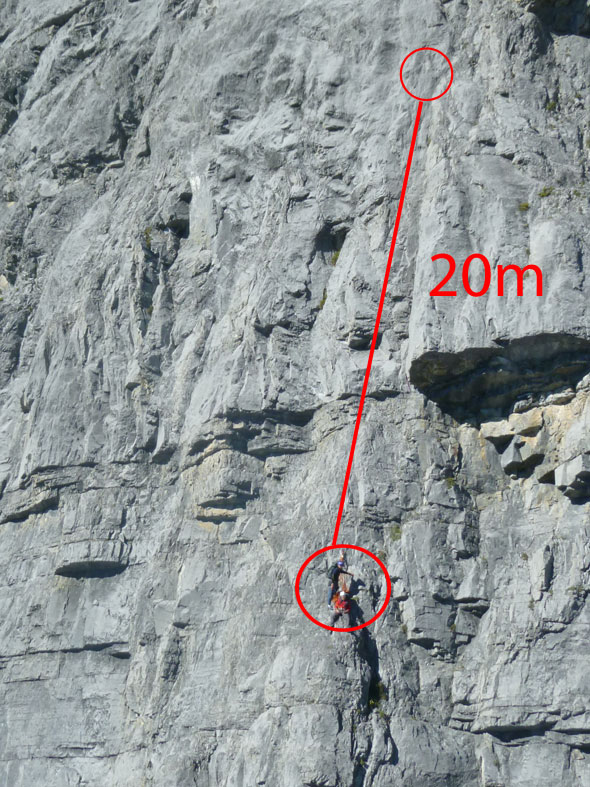
The upper circle indicates where the leader was when he fell. The lower circle indicates where he stopped. They can also be seen in the lower circle. The total distance of the fall was approximately 20 metres.
© Parks Canada
Analysis
Given that the party was sufficiently experienced for the undertaking it can only be said that sometimes, “things happen”. Loose rock is a fact of life in the Mountain National Parks, and sometimes it can come loose and knock climbers off their stance. It is also important to note that this lead climber did a good job of placing adequate protection on his lead. The top piece happened to pull out, but once again these things can happen. Above all, the protection he placed did what it was supposed to do, and that was stopping his fall. The patient ended up suffering a broken ankle, broken ribs and resulting pneumothorax in the lung, dislocated shoulder, point tenderness in his back and spine, as well as a lacerated face. His helmet was cracked and wearing one likely saved his life.
William Holland, Slipstream, Jasper National Park, Aug 15, 2010
Slipstream is legendary. Nearly a vertical kilometre of ice, the frozen waterfall is much more of an alpine odyssey than many of the other pure ice climbs in the Columbia Icefield area. A prized objective of advanced climbers, the sheer magnitude of Slipstream has turned away many parties. Others has been chased off by avalanches while approaching the frozen giant and a select few have been granted successful passage up the grand east face of Mount Snowdome. And then there are those who went toe-to-toe with the champ but didn't return to tell the tale.
On April 3, 1989 two parties set out to climb Slipstream. Bill and Chris, a visiting American pair took advantage of the steps that a team of local climbers left as they trudged up the easy terrain of the lower half of the route. Ken and Rick introduced themselves when the two parties took a break together and they all agreed that the Americans would strike off first up the steep ice that remained. A good decision, the leading party moved steadily and widened the gap between the teams. Both pairs were able to top-out after "uneventful" ascents.
As any experienced climber understands reaching the top of a climb is only the halfway point of the day. Chris and Bill celebrated the climb with a little lunch. After hours in a near vertical environment the flat walk along the top Mount Snowdome seemed like just that, a walk. The pair began moving towards the descent route in windy and occasionally white out conditions. Bill carried the coiled rope on his back, ready for quick deployment. Struggling through the poor visibility Bill probed with his ski pole as he approached the corniced edge of Snowdome hoping to get a glimpse of the proper descent gully. Chris watched intently but there was nothing he could do when the ground broke loose and Bill disappeared out of sight. Shouts disappear into the wind and the monochromatic environment. The howling wind is deafening and silent at the same time. Chris stands alone. Hope is all he has. Hope that Bill will reply to his calls. Hope that Ken and Rick will soon arrive.
After an hour and a half there was no sign of the local climbers, Chris decided to make his way towards the route home. Stress affects your ability to make even the most basic of decisions but the uneasiness of striking off down the technical descent, rope-less and alone, was too much for Chris. He backed off and paced back and forth as he weighed his options when Ken and Rick came into view.
The three teamed up and proceeded down from the upper reaches of the mountain. Relentlessly, Snowdome continued to abuse the climbers. Ken fell into a bergschrund and Rick dislocated his shoulder during their retreat to their base camp. It was now time to take care of Rick and after getting him settled and somewhat comfortable, Chris and Ken skied to the highway to call for help.
Parks Canada's rescue teams began their efforts early the next morning. Rick was safely evacuated by helicopter before 10 am and the search was on for Bill. Deteriorating weather kept the helicopter grounded for most of the day. Ground search efforts were held at bay by the high avalanche danger. By days-end there was no sign of Bill and winter weather had descended on the Columbia Icefield once again.
Skies began to clear through the afternoon of April 8 and several explosives were deployed along the gullies of Mount Snowdome. "Good results" meant that perhaps a search dog team could be flown into the area. The original rescue report also noted a "monster ice fall" off the summit of Snowdome which obscured the area with a snow powder cloud for more than 5 minutes. The avalanche dog, handler and one other searcher were able to spend a little more than an hour searching avalanche debris below the area where Bill fell. In the mean time the helicopter scoured the east facing wall of Snowdome. The search teams were safely removed from the glacier in the fading evening light.
While the sun had returned to the area, the next morning's flight revealed another huge ice fall that had occurred overnight, completely obliterating the area where the search dog team had been working the day before. In the absence of a single clue, the search was suspended due to the extreme hazards faced by the rescue parties.
Adam and Matt were having a great summer living and working in Jasper National Park. Taking advantage of their summer backyard the two hiked up on the moraine covered Dome Glacier. The glacier is fed by a huge icefall on the west of Snowdome and a lesser icefall to the east. The east lobe tumbles several hundred metres from a cirque below the east face of Mount Snowdome. Trekking around under the hydrological apex of North America on a perfect summer day is nothing less than spectacular. That is until you stumble across the mummified remains of a climber from by-gone days. .
On August 15, 2010 the body of a climber was discovered by two hikers on the Dome Glacier beneath Mount Snowdome. The RCMP and Medical Examiner's office were able to confirm the identity of the deceased. Using a helicopter, Parks Canada's rescue team was able to recover the body of William Holland of Gorham, Maine on August 16. Mr. Holland's next-of-kin were notified on August 26, 2010, closing a missing person file that has been open for the last 21 years.
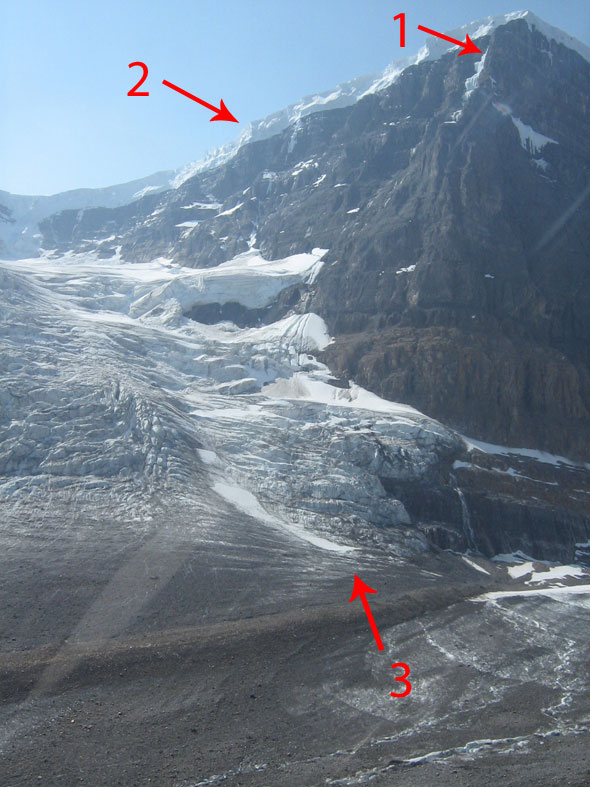
1. The top of the ice climbing route, “Slipstream”.
2. Fall occurred, April 3, 1989
3. Body located, Aug 15, 2010
© Parks Canada
Stranded Scrambler, Rockbound Lake, Banff National Park, Aug 23, 2010
A group of three inexperienced scramblers from Calgary departed the Rockbound Lake trailhead at 06:00 am with the intentions of climbing the scrambling route on Castle Mountain. The ascent went relatively smoothly. They were descending from the summit and the group decided to take a short cut. They saw the Lake below and decided to descend straight towards it. The regular route goes around a major cliff band and does not descend straight to the lake. They descended roughly 200m of 4th class and easy 5th class terrain. This means they were down climbing using hands and feet and the possibility of a fall was severe. They then encountered a steep headwall where the climbing got even harder. Two of the three somehow made their way down this headwall without falling off. The third party member waited wisely at the top of the steep drop and called to his friends to get him some help. One of his friends waited at the lake while the other ran down the trail to call out on his cell phone.
The initial report that came to Banff Dispatch had very little information. The call was being dropped because of the weak signal. It was suspected at first that the suspect had injuries and was located near Rockbound Lake. Two Visitor Safety Specialists were wrapping up another incident in Lake Louise when they were notified and flew directly to Rockbound Lake. Because of the possibility of an injured person in steep terrain two other VS Specialists were called in from Banff and Lake Louise. The team in the helicopter quickly located the stranded scrambler and ascertained that there were no injuries. The other VS specialists were stood down. Because the equipment was already on board the helicopter, one of the specialists slung up to the stranded scrambler after staging from the shores of Rockbound Lake. The rescuer dressed the subject in a screamer suit and slung back down to the lake. He was reunited with his other friend and they walked back down the trail to meet up with the third member in their group.
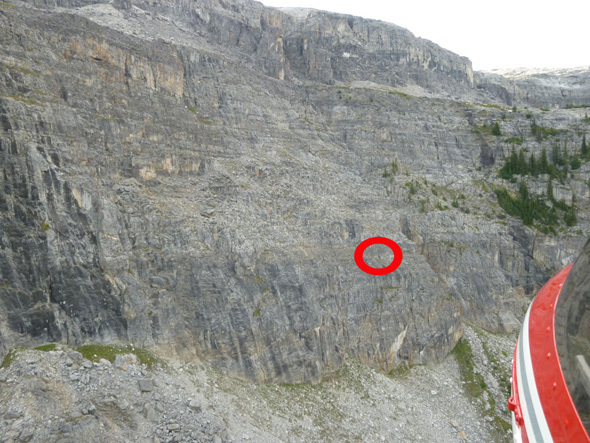
The stranded scrambler can be seen circled in red. This photo was taken from the helicopter during scene surveillance. Note the extremely steep terrain above and below him.
© Parks Canada
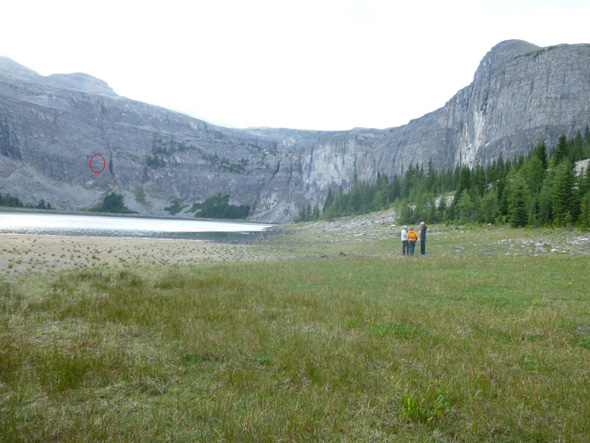
A Visitor Safety Specialist debriefs with the stranded scrambler and his friend. The location of the recovery is circled in red.
© Parks Canada
Analysis
It was clear that the group decided to take a short cut back to Rockbound Lake. This is never encouraged. Most times trying to take a short cut ends up in a situation like this and taking much longer than anticipated. The two party members who decided to move through the steep headwall put themselves at great personal danger given their experience level, and were very lucky not to have fallen off. The remaining subject who became stranded made the right choice by not attempting to down climb a steep headwall with little to no experience and called for help.
Stranded Scramblers, Mt. Rundle, Banff National Park, Aug 23, 2010
A pair of inexperienced hikers decided to hike/scramble to the top of Mt. Rundle. They left the trail head at the 15th hole at the Banff Golf Course at 11:00am. They soon lost the trail while they were still below tree line. They started climbing straight up from the trail and eventually were funnelled into a steep gully. They continued up scrambling over difficult and loose terrain. When they were approximately three quarters up the gully feature they stopped and called for help through Banff Park Dispatch.
Three Visitor Safety Specialists were dispatched from Banff to deal with the situation. Cell phone contact was made with the subjects by the rescue team in the helicopter. This assisted the team in finding their location exactly. They were located in a deep gully feature with an overhanging wall above them. The terrain feature was too steep for the helicopter to sling the rescuers directly to the site. The Visitor Safety team assessed the situation and decided it was best to sling to a spot nearby and extricate them to a safe spot so they could be slung out with the helicopter. The first rescuer slung in to a site above and to the side of the stranded subjects. The rescuer then rigged an anchor as the next two specialists were slung in to the site. When all three rescuers were onsite one of the rescuers was lowered down to the subjects. They were subsequently rigged with screamer suits, (harness like device), and were belayed back up to the other rescuers (used a rope to safeguard a slip or fall). From this point forward the subjects were slung out to the staging area at the Banff Golf Course as the last rescuer retrieved the gear.
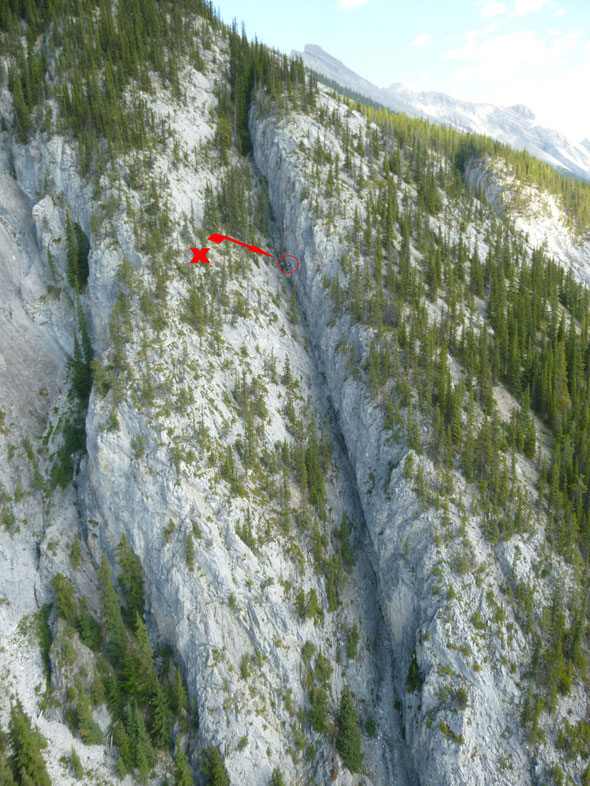
The subjects are circled in red. Visitor Safety Specialists were slung to the 'X' and retrieved the stranded scramblers by ground along the red arrow.
© Parks Canada
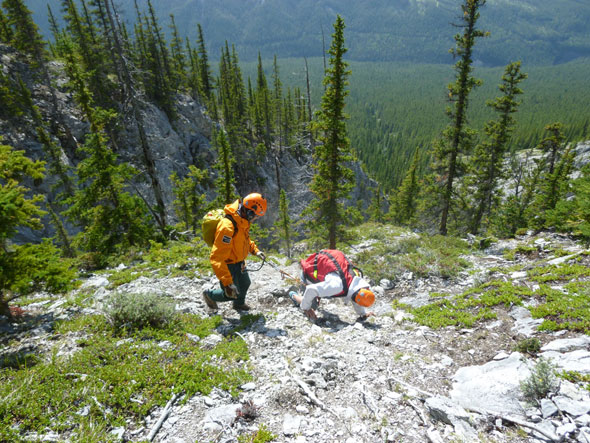
A Visitor Safety Specialist short ropes one of the subjects to a spot where they could be slung off to the staging area. All Visitor Safety Specialist are certified Mountain Guides with the Association of Canadian Mountain Guides. Short roping is a technique crucial to Mountain Guiding and rescue work within the Mountain National Parks.
© Parks Canada
Analysis
The hikers were very inexperienced and new to the area. They were not aware of the hazards involved in mountain travel. They did have the sense to call for help when they got in over their head, and did not try to force the situation by continuing up or down. One of the subjects had skateboarding shoes which is inappropriate footwear for such an outing. A sturdy hiking shoe or boot with a decent tread is highly recommended. Visitor Safety has produced a scramblers guide pamphlet for Mt. Rundle and it is highly recommended that scramblers pick up a free copy at the Banff, Lake Louise, or Yoho information centres.
Stranded Scramblers, Devils Thumb, Banff National Park, Aug 7th, 2010
A party of three left Calgary early in the morning with the specific goal of scrambling up the Devils Thumb above Lake Agnes. They were very inexperienced but made it to the summit none the less. Two other family members accompanied them to Lake Agnes. The group had two way radios between the Lake and the scramblers on the Devil's Thumb. The three scramblers called in from the summit to their family members at the Lake and informed them they were exhausted and too scared to make it back down on their own. The family member at Lake Agnes then called Banff Dispatch to request a rescue.
Two Visitor safety Specialists were dispatched from Banff and one from Lake Louise. The three specialists flew to do scene surveillance on the Devil's Thumb. The party was located on the opposite side of the Thumb from Lake Agnes in an area with gullies, cliffs and bush. The three rescuers were slung in to the subjects in three loads with screamer suits. The subjects were then rigged and slung out in 3 loads, each subject accompanied by a rescuer. They were delivered to Lake Agnes where their family was waiting, and they continued down to Lake Louise on foot. There were no injuries associated with this case.
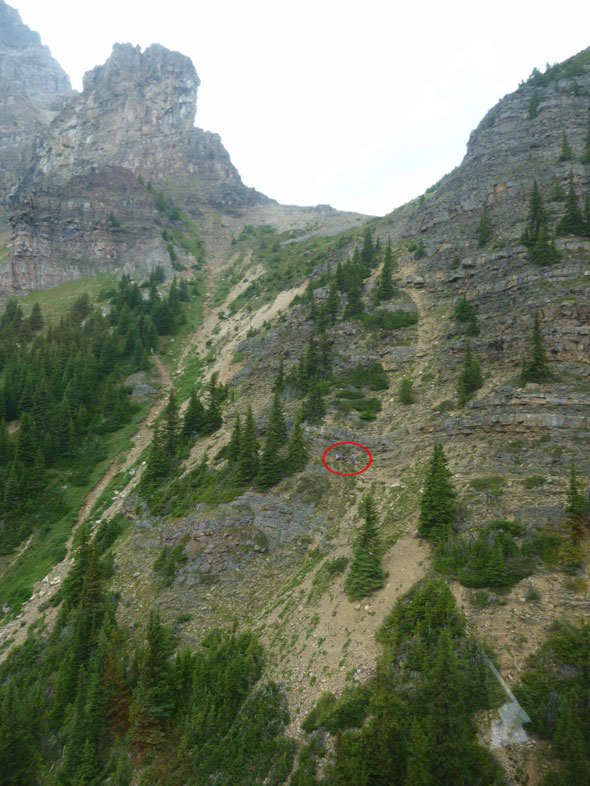
The two climbers can be seen circled in red.
© Parks Canada
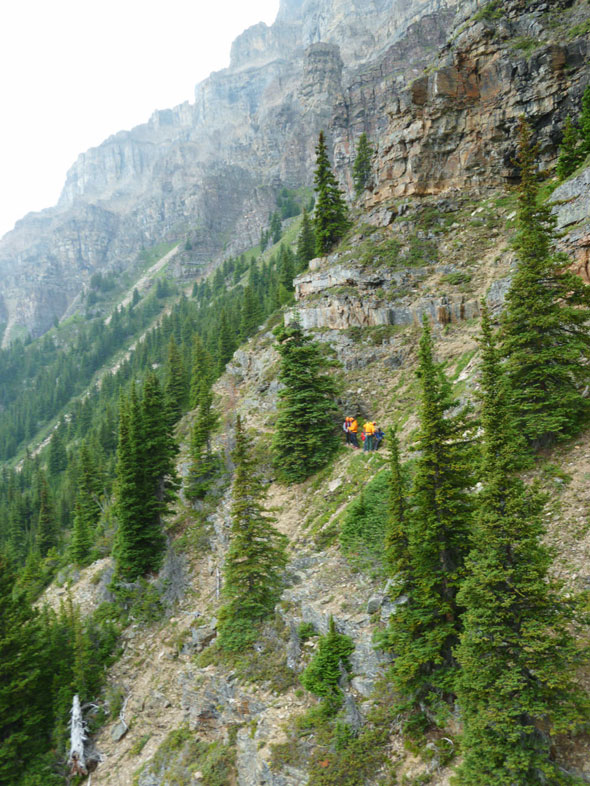 A Visitor Safety Specialist prepares to grab the line and sling out with the first stranded mountaineer.
A Visitor Safety Specialist prepares to grab the line and sling out with the first stranded mountaineer.
© Parks Canada
Analysis
This was a case of people getting in over their head. They did not realize what it would take to safely ascend this peak. Also they did not make any attempts to retrace their footsteps back down the route they came up. It was good that they did have the sense to stop and call for a rescue when they did in fact get in over their head. It is recommended that Park Visitors, no what their experience levels, do as much research on an objective as possible. One way of doing this is to contact the Banff, Lake Louise, or Yoho visitor centers, which can provide up to date information, and/or direct them to speak with a Visitor Safety Specialist.
Stranded Climbers, NW Ridge of Mt. Sir Donald, Glacier National Park Aug 6, 2010
Intending to climb the classic NW ridge of Mt Sir Donald from their car in a day, two climbers from out of country set out from their vehicle at 0400. Upon reaching the Sir Donald Uto col, the two chose to rope up and commenced the climb by 0815. The climbers soon realized that the climb was taking them longer than expected but chose to continue, reaching the summit by 1600. On the descent, the pair struggled with the loose rock and route finding on the West Face Bypass, losing more time. Finally regaining the NW ridge, they did one rappel before realizing that they would soon lose daylight. At a decent ledge, the climbers decided to stop and bivy for the night, thankfully noting that the forecasted evening thunderstorms had not materialized. Unfortunately, the timing of the forecast was off, and they found themselves bivying at 3020m in a thunderstorm and heavy rain. By 0530, cold and wet, the two decided to call for rescue concerned that, given their state and the now wet and greasy quartzite, they would not be able to safely complete the descent.
Visitor Safety was notified by the Parks Canada Emergency Dispatch and contacted the climbers via their cell phone, assessing their situation and location. Three Visitor Safety Specialists responded with a rescue helicopter from Revelstoke. The party was easily observed on the ledge during their reconnaissance flight, and the VSS team staged from the meadow below the col. One rescuer managed the staging area, while two rescuers heli-slung onto the site with equipment. The climbers were slung off separately in “screamer suits”, each with a rescuer. The party was flown down to the staging area, returning to Rogers Pass by helicopter by 0900.

The stranded mountaineers are circled in red high on the ridge of Mt. Sir Donald. Two Visitor Safety Specialists can be seen slinging into the site.
© Parks Canada
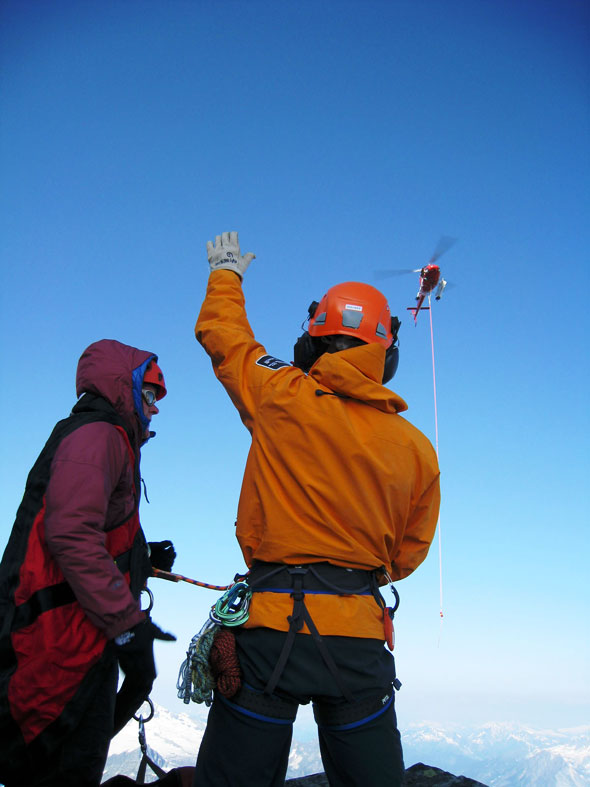
A Visitor Safety Specialist prepares to grab the line and sling out with the first stranded mountaineer.
© Parks Canada
Analysis
As written in the “Selkirks South” guide book and evident in the numerous trip reports posted on the internet, an ascent of Mt Sir Donald is a serious undertaking and one that many parties underestimate. Groups must climb swiftly and efficiently to complete the route safely, and it is not uncommon for the descent to take longer than the ascent. This group chose to continue with their objective, even when the ascent was taking longer than anticipated. It is good practice to set a turn around time. It is better to abandon an objective than to require a rescue. The group made the appropriate decision to request a rescue when they recognised that they did not feel they could continue safely. Had they chosen to continue, the situation may have become more serious, putting themselves and their rescuers at greater risk.
Stranded Scramblers, Mt. St. Piran, Aug 6th, 2010
A party of three decided to take the standard route up Mt. St. Piran, which involves mostly a trail and some very easy scrambling and walking in scree near the summit. They made the summit in the mid afternoon and were planning on descending directly to Lake Agnes. They had some information that a route was possible in this direction but it was very obscure and there was no marked trail down that side of the mountain. They travelled in this direction only to get lost in the cliffs and rock bands above the Lake Agnes. They tried many different ways to make it work but based on their experience and comfort levels were not able to descend safely to the Lake. By this time it was late in the evening and they were too exhausted to climb back to the summit and descend the main trail. The called Banff Dispatch and requested a rescue.
One Visitor Safety specialist was dispatched from Banff via helicopter while another was to be picked up in Lake Louise. A third Parks Canada staff member was securing a staging area at Fairview Pit, off of the old 1A Highway. The VSS crew flew to St. Piran and started a search for the scramblers. It was initially difficult for the Specialists to spot the stranded subjects. A rescue team member then phoned the stranded person while in the helicopter and the stranded scrambler guided them in to their location. From here the two specialists staged from the Lake Agnes Tea House and slung up to the three subjects. Two of them were slung down to the Parks Canada staff member at the Fairview Pit while the third scrambler was rigged for slining. After two more trips everybody was safe and sound at the Fairview Pit.
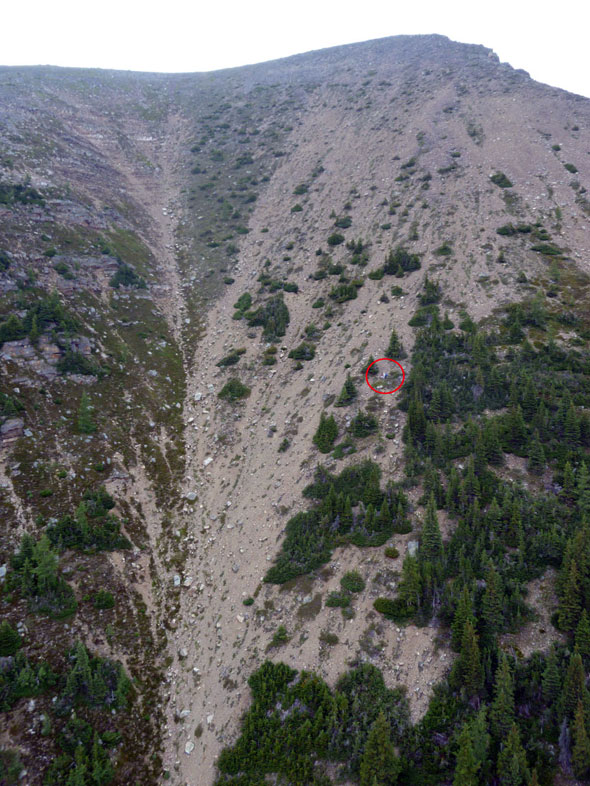
The stranded scramblers can be seen circled in red.
© Parks Canada
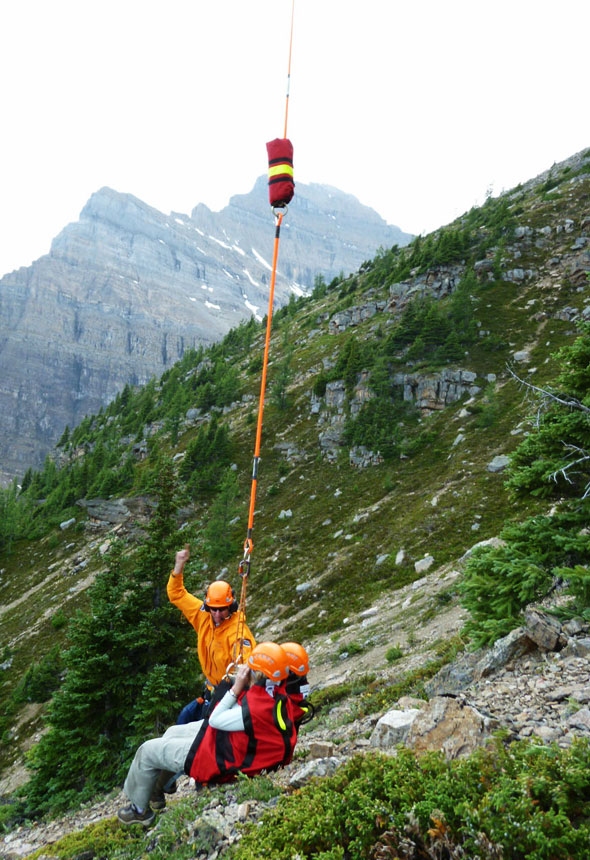
A Visitor Safety Specialist slinging the first subject from the ledge as the second specialist rigs the second subject.
© Parks Canada
Analysis
The standard way up Mt. St. Piran was within the party’s abilities. It does seem that going down another direction was beyond their experience level. It is unknown why they chose a route like this with so little experience. They did have the sense to stop while they were still safe and called for a rescue when they felt they were in over their head. This was a good judgement call on their part. Too often people push beyond what is reasonable for them and get into very serious situations? Because of this decision a rescue was easily facilitated.
Slip On Snow, Mt. Robson, Robson Provincial Park, Aug 2, 2010
A party of two left the trail head on July 31 with intentions of climbing Mt. Robson via the Kain Route. They had planned to be back at the trailhead having summited the peak on August 4th. They had attempted Mt. Robson twice before unsuccessfully. They described themselves as non-climbers who, “have wanted to climb Robson since they learned about it”. Both subjects were fit and carrying decent equipment. They had ascended the Robson/Resplendant col (R/R col) to avoid the notorious Robson ice icefall. The R/R col was the higher than any other point they had reached on their previous trips. They were moving beyond the col in the direction of the Kain Face on the ridge in poor snow conditions. They were travelling un-roped with crampons and ice axes. One of the climbers collapsed one of the steps in the snow and he proceeded to fall and tumble approximately 250m to the glacier below. Luckily the snow was quite soft at the time and this prevented serious injuries. He was also lucky to have bounced over the bergschrund, as opposed to falling in it. His fall came to a stop as the terrain gradually flattened out. His partner down climbed to the fallen subject, repositioned him to a flatter and safer location, set up their tent, and called for a rescue with a “SPOT’ GPS locator device by activating the 911/SOS feature of the beacon. The fallen climber had remarkably minor injuries which included several puncture wounds to his legs from his crampons, a broken wrist, and some broken fingers.
Jasper Dispatch was notified of the incident from BC Park Rangers at Robson Provincial Park. Three Visitor Safety Specialists were dispatched from Jasper via helicopter as more Parks Canada staff were dispatched via ground to a staging area. Jasper VSS flew directly to the coordinates provided by the “SPOT” device and located the climbers immediately. They were able to land next to the climbers treat the injured subject, broke down the camp and flew them to the staging area that other Parks Canada staff had secured. BC Ambulance was waiting to receive the patient.
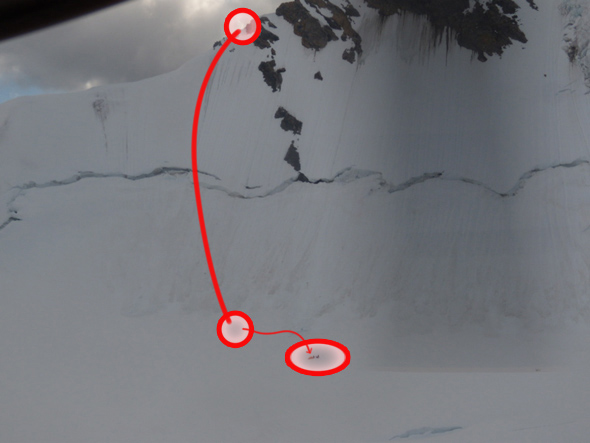
The climber fell between the two upper circles. The climber was then repositioned to the larger circle with the arrow pointing it. The climbers can be seen in this lowest circle which gives some scale to the photo.
© Parks Canada
Analysis
The climbers were relatively inexperienced albeit well prepared. It is widely known that climbing late in the day posses its problems and hazards. Beyond losing footing in slushy and moist snow, avalanches and rock fall are more likely in the warm temperatures of the afternoon. It is advised that climbers only undertake objectives that they know they can safely complete before snow conditions become poor late in the day or readjust their plans accordingly.
Fall While Scrambling, Mt. Norquay, Banff National Park, July 30, 2010
Two friends visiting from out of the country decided to scramble up Mt. Norquay by the regular scrambling route. They met another two people on the way and scrambled together for the duration of the outing. They made the summit at about 15:00 hours. For reasons unknown they did not retrace their steps and descended down the fall line from the summit. They down climbed many steep sections and were spread apart by 10 to 15 meters. One member of the party then fell approximately 15m hit the scree bowl below and tumbled another 15 to 20 meters before coming to a stop. The group called Banff Park Dispatch to report the incident and to call for a rescue. After calling the incident into dispatch they descended to the fallen subject.
Three Visitor Safety Specialists were dispatched from Banff. Given the close proximity to Banff the VSS crew was on scene in less than half an hour. Upon scene surveillance the team discovered the four individuals in a scree bowl below a vertical cliff face. Two rescuers were slung into the site with equipment. The footing was steep and loose so working conditions for packaging the patient were challenging. One rescuer attended to the patient while the second rescuer scuffed out a ledge for the stretcher. The subject was then attended to and slung out with rescuer number one. The subjects friend was slung out with rescuer number 2 in a “screamer suit”, while the other two went down on foot. The incident was wrapped up by 1730 hours.
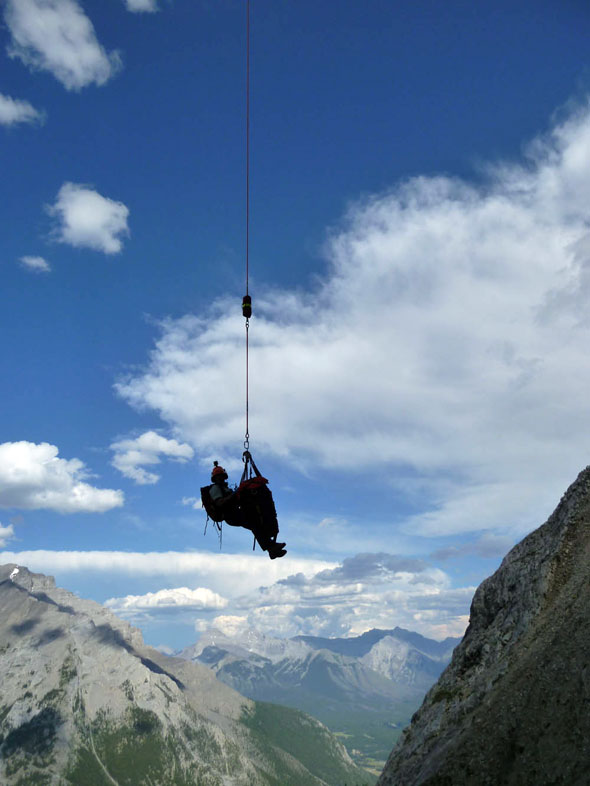
A Visitor Safety Specialist slings the patient to Banff EMS at a staging area.
© Parks Canada
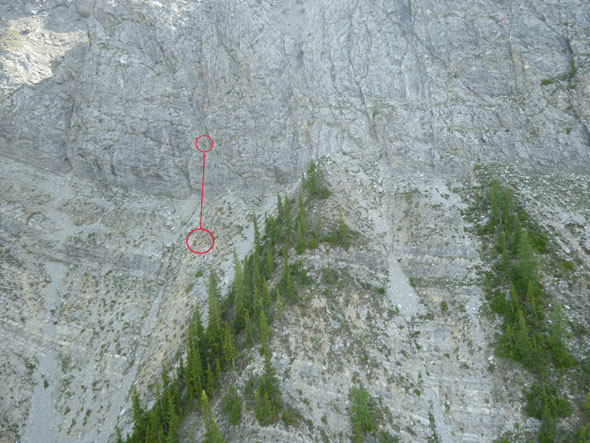
The subject fell from the upper red circle and can be seen inside the lower red circle below.
© Parks Canada
Analysis
Lack of mountain awareness and experience was the major factor in this accident. Predominantly the decision to descend a different way (or rather the unawareness that they were going a different way) was the reason for encountering terrain that was beyond their capabilities. The second decision to carry on after encountering difficulties was another factor in this fall. Having the ability to retrace your footsteps and to be able to recognize the terrain you once travelled up is a key component to remaining safe while scrambling.
Stranded Climbers, Lake Louise, Banff National Park, July 21, 2010
Two climbers set off to climb The Kaleidoscope Pinnacle opposite of the classic rock climbing area at the back of Lake Louise. They finished the climb and were intending to do the “walk off” descent. They encountered a 4th class section of terrain and made the decision to leave the rope behind and climb solo up to where they thought the descent ledge was. It turned out that this ledge system was not the correct way to descend so they attempted to return to the top of the route. When they encountered the 4th class section again, they were unable to descend it safely. They then traversed the ledge a second time and began to call for help. Tourists on the very busy lake shore trail heard the cries for help and phoned Banff Park Dispatch to report the incident.
Three Visitor Safety Specialists were dispatched from Banff via helicopter while a fourth specialist was dispatched by ground from Lake Louise. The specialist in Lake Louise rode his bicycle with his personal gear to the back of the lake to survey the situation. When he arrived he relayed back to the other three the latest information on the situation which was, two climbers are stranded above Kaleidoscope Pinnacle Wall, appear unable to descend under own devices, and are waiting for rescue. The team of three surveyed the scene when they arrived by air and staged out of the meadows at the back of the lake. One rescuer was slung up to the site with personal gear and a screamer suit for one of the subjects. He indicated to the second rescuer that he was wearing a climbing harness that was in good shape and only needed to bring a lanyard to clip to subjects harness. The second rescuer was slung in as the first was rigging the first subject to be slung out. As the first rescuer and subject were slung out, the second rescuer was preparing the second subject. The helicopter then returned for the remaining group on the ledge. After cleaning up the gear and loading the helicopter the two climbers walked back to the base of the climb to collect the rest of their belongings. Neither climber was injured in the incident.
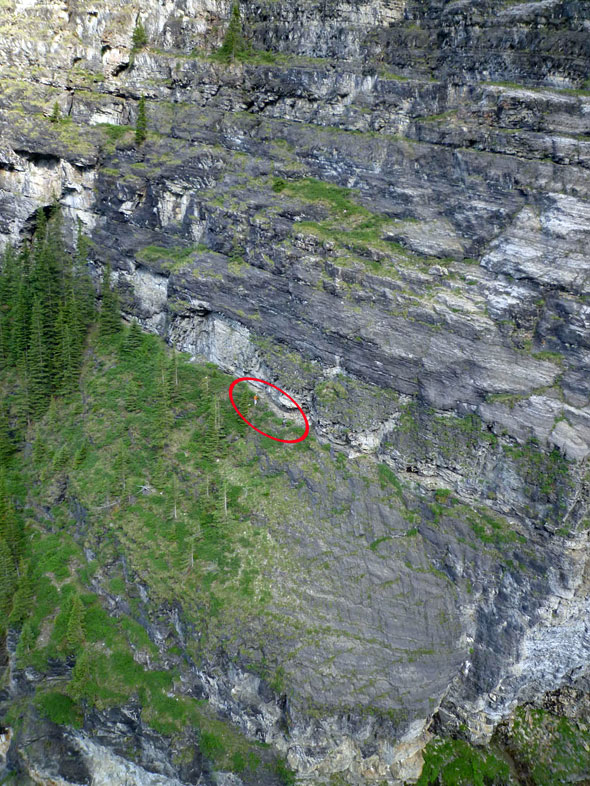
1. The two climbers can be seen circled in red.
© Parks Canada
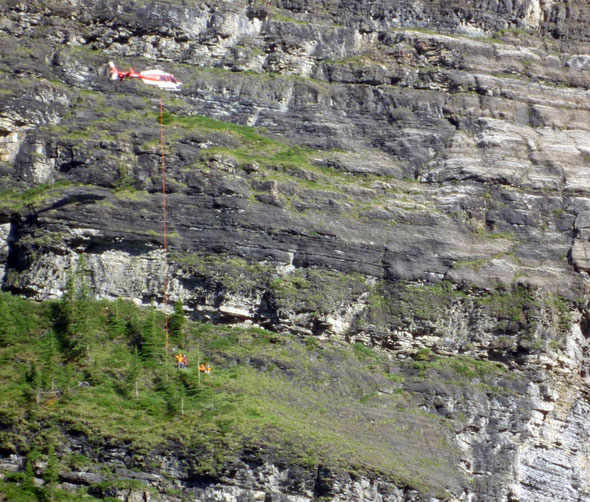
2. A Visitor Safety Specialist slinging the first subject from the ledge as the second specialist rigs the second subject.
© Parks Canada
Analysis
The two climbers had a moderate amount of experience. The climbing was well within their abilities however this situation seemed to be a wrongful interpretation of information about the descent. The other decision to leave the rope behind proved to be the final error which prevented them from descending under their own devices. At this point in time they wisely counted their losses and called for a rescue. Climbers are advised to always bring their safety equipment with them at all times even if something does seem very straight forward, and it would be plausible to return to where they had left.
Stranded Scramblers, Cascade Amphitheatre, Banff National Park, July 21, 2010
On July 21, 2010, a party of four scramblers, three females and one male set out to climb Cascade Mountain via the normal scramble route. On the descent, the male decided that he wanted to take a short-cut down the north side of the mountain rather than return the way they had come up. The three females were against this plan, but the male took off without them. After some discussion, the girls decided to follow. They then down-climbed some very steep and treacherous terrain to a spot where it was obvious that they could go no further. At this point they knew they were stuck as they could not go back they way that they had come, so they wisely called for help on their cell phone. Luckily, they could get reception from this point and the Parks Canada dispatcher advised them to sit tight and not move, help was on the way. Parks Canada mountain safety specialists responded to the call and were aghast when they saw the location that the girls had ended up. They were extremely fortunate that no one had slipped while climbing down to where they were. Helicopter sling rescue was used to fly the girls off the mountain and down to the amphitheatre. Meanwhile, the male in the party showed up also having successfully traversed some very dangerous terrain alone.

The terrain around the subjects was very unforgiving and extremely technical. They were smart not to push it ANY further, and to call for assistance.
© Parks Canada
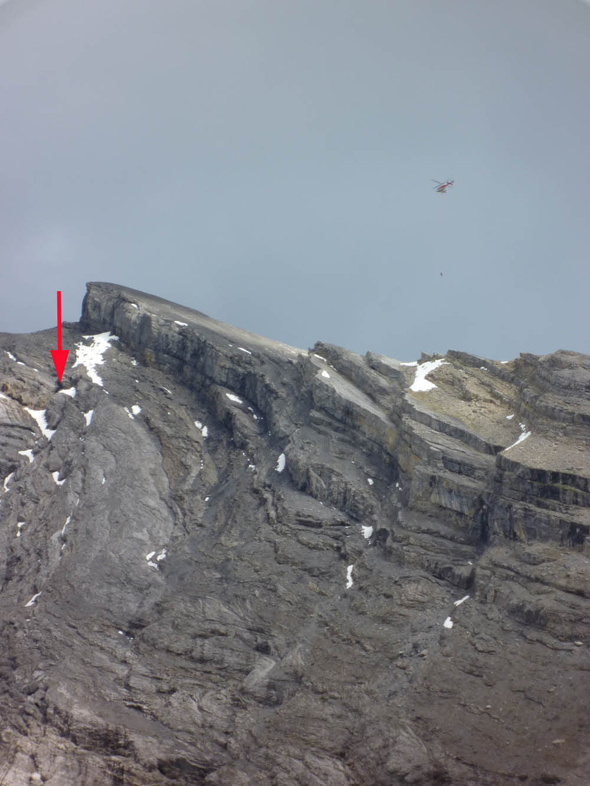
A Visitor Safety Specialist is being slung into the subjects location, which is indicated by the red arrow.
© Parks Canada
Analysis
Parks Canada reminds visitors not to take short cuts and to never descend another route than the ascent route unless they are absolutely confident that it is a possible route. The Parks Canada “Scrambler’s Guide to Cascade Mountain” shows X’s on the guide where previous parties have fallen to their deaths very near to where the girls were rescued.
Leader fall, Mt. MacDonald, Glacier National Park, July 7, 2010
A party of two set off to climb a route on MacDonald called “Prime Rib”, on the North Face of Mt. MacDonald in the early hours of July 7, 2010. “Prime Rib”, is a relatively new route that was climbed for the first time in 2004. The climbing party was ascending the first pitch and had started up a low angle slab section above a large ledge where the rescue eventually took place. They were climbing a corner that was quite mossy and dirty. The leader believes he pulled on a hold that was actually just a loose rock in the moss causing him to take what is estimated to be a ~ 15m fall stopping adjacent to the ledge. The leader described bouncing and hitting the wall as he fell. When the fall stopped he was able to build an anchor and belay his partner up to him. They then proceeded to descend to the large ledge where the climb started from, and called for a rescue via cell phone. The leader sustained and injured ankle, elbow, and ribs in the fall. No other injuries were incurred.
Visitor Safety Specialists responded form Banff via helicopter and Revelstoke via ground. The three specialists met at the rescue base in Rogers Pass and flew to Mt. MacDonald for scene surveillance. The weather was clear and the wind was calm which enabled two of the specialists to sling into the ledge where the climbers were. The two specialists rigged the climbers to be slung back down to the staging areas adjacent to the Trans Canada Highway. After the procedure was finished the climbers self transported to the hospital in Revelstoke.
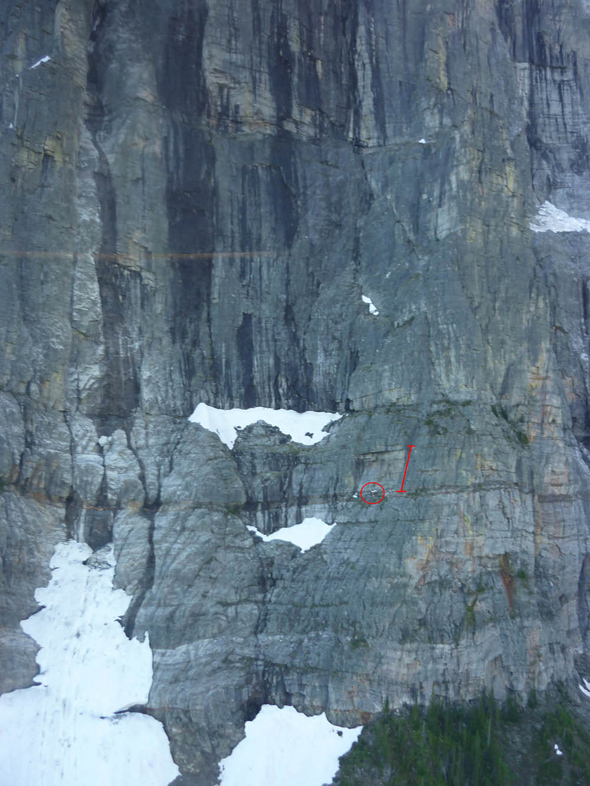
The red circle shows the two climbers location, while the red line shows the approximate location and distance of the leader fall.
© Parks Canada

This is an aerial view of the climbers looking straight down during scene surveillance.
© Parks Canada
Analysis
The leader was placing protection while climbing the initial pitch of this route, and this likely prevented major injury. The climbing team was very experienced and had the ability to recognize that in unknown and lower angled terrain falling was still possible. Sometimes climbers just slip, or pull off loose holds, no matter how experienced they are. In this case, having placed protection on this pitch paid off for them in full.
Fall Off Cliff, Mt. St. Piran, Banff National Park, June 24 2010
A group of 4 scramblers had made an ascent of Mt. St. Piran from the Lake Agnes Tea House. On the descent they chose a route that went directly over a cliff band that was approximately 8 to 10 meters high. One of the party members threw her pack down onto a ledge on the cliff and decided to jump down beside it. Upon landing she slipped and fell an additional 4 to 5 meters, sustaining injuries to her head and face. The final impact zone was a snow patch and this likely mitigated serious injury. The rest of the party scrambled down to her and called the accident in to Banff Dispatch via cell phone, and were connected to Parks Canada Visitor Safety’s Rescue Leader on shift. They then descended approximately 100m further down slope and decided that it was too taxing and waited for Visitor Safety Specialists to arrive.
Two Visitor Safety Specialists responded from Banff via helicopter, while a third was preparing gear in Lake Louise. The helicopter flew directly to the scene to do surveillance. The scramblers were easily located. The Visitor Safety Specialists staged out of the Lake Agnes Tea House heli pad and slung up to the group. The helicopter returned to Lake Louise and slung in the third Visitor Safety Specialist. The three rescuers worked to package the injured person and slung her directly to Lake Louise and waiting Banff EMS. The rest of the group decided to walk back down, and the remaining rescuers slung down to Lake Louise with the rescue equipment.

This photos shows the cliff in which the subject had fallen off. The exact location is marked with the red circles.
© Parks Canada
Analysis
A number of factors play a role in this accident. The group had limited experience and were new to the area having arrived for summer employment. Their limited experience was the primary factor for choosing to down climb the cliff itself when many other options for skirting around it were available. It was late in the day, (approx 19:00 hours) and rain showers were moving through the area. They were feeling rushed based on the hour and the rain showers make the Quartzite rock extremely slippery. Visitors who are new or unfamiliar with the area are encouraged to seek information and advice at Park Information Centers.
Fall off Cliff, Peyto Lookout, Banff National Park, June 20, 2010
A group of three people who were sightseeing on the Peyto Lookout near Bow Summit decided to walk beyond the established trail to take some pictures. They continued approximately 150m where a rock bluff overlooks Peyto Lake. They were taking turns sitting at the edge of the cliff and taking pictures with the Lake below. A male aged 37 was sitting down having his picture taken. He went to get up from the sitting position after his picture was taken and caught his foot in a crack. He subsequently fell over backwards and off of the cliff. He fell seven meters into boulders and snow sustaining two major fractures of his right leg, one in his ankle and one in his femur. This happened at approximately 13:00 hours. His friends were able to hike around the cliff to access the fallen subject. After determining that his injuries were severe a member of the party hiked back out to the road and drove one kilometre to Num Ti Jah Lodge to place a call through 911. This lodge is the closest phone to the accident site.
It is important to note that there is no cell phone coverage along the Ice Fields Parkway. 911 transferred the call to Banff Dispatch, and the reporting person was connected to Visitors Safety’s Rescue Leader for the day. The person was questioned and then instructed to return to the accident site and wait for Visitor Safety staff to arrive on scene. One Visitor Safety Specialist arrived on foot after driving from Lake Louise, the second Specialist flew from Banff. A helicopter sling rescue was necessary to transport the subject from the accident site to the staging area where Banff EMS was waiting.
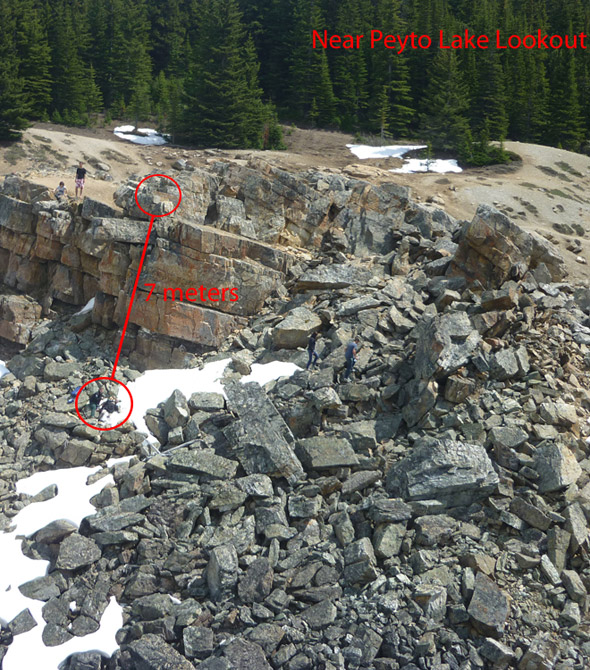
The top circle indicates where the subject was when he fell, the lower circle indicates where he stopped. A Visitor Safety Specialist can be seen attending to the subject in the lower circle.
© Parks Canada
Analysis
Visitors to National Parks should always remember that any areas that are essentially, “off the pavement”, are wild and uncontrolled areas and that awareness of their surroundings is crucial at all times. Specific to areas near edges extra caution should be exercised when approaching or standing near edges. Extra margin should be given to allow for trips and falls. It is better to trip and land on your knees, rather than tripping and falling off a cliff.
Uncontrolled Glissade, Whistler Mountain, Jasper National Park, May 1, 2010
A 31 year old female hiker, travelling alone, from Vancouver, hiked up the summer trail to the top of Whistler Mountain where the upper tramway building is located. She was staying at the Whistler hostel located at the bottom of the mountain while in Jasper. She was in jeans, a light jacket, ankle high cotton socks, light hikers, and a small day pack with no extra relevant supplies. The trail typically takes 3 hours in dry conditions and leads into the alpine ultimately to the upper tramway station.
As she left the tree line, she was likely post holing in deep snow for the majority of the trail. The tramway closed at 1700hrs. It is suspected she arrived at the upper tram station after this time. She was likely cold, hungry, wet, tired, and dehydrated. She probably observed the lights or building of the hostel that she was staying at and began descending in a straight line towards it. The snow conditions consisted of a hard slippery crust. Her initial tracks appear to be steps in the snow quickly turning into a bum slide which likely resulted in an out of control glissade down the steep snow slope. 150m down her track ran into a rock where she was catapulted as divots in the snow attest to. She slid another 200m down slope where she eventually stopped. She spent the night out at this location. The next morning at 0930hrs, tramway maintenance staff a body from the tramcar and notified emergency dispatch. A subsequent rescue operation determined she was deceased and recovered her body.
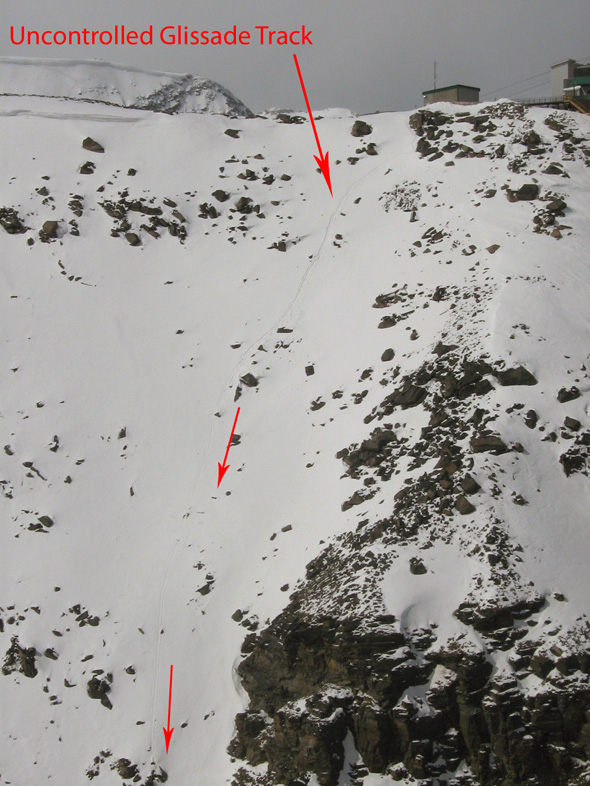
This photo indicates where the subject slipped, and the subsequent track that she left during the uncontrolled glissade.
© Parks Canada
Analysis
It is uncertain as to the exact nature of the events leading up to this fatal accident. She was also found to have a cell phone on, and in her pocket. It is important to note that her uncontrolled glissade track was discontinuous. This would indicate that she may have made efforts to stop her fall at various points along the descent. Upon aerial observation of her track it was noted that she travelled sideways intermittently during the fall. Her exact cause of death is still to be determined officially by the medical examiner’s report. One can assume it is a combination of traumatic internal injuries and exposure.
Leader Fall, North Face of Mount Temple, Banff National Park, March 25, 2010
A party of two very experienced alpine climbers set out to climb a new route on the 1500m North Face of Mount Temple in winter conditions. They ascended the “dolphin” which is a long snow and ice feature on the face finding good snow conditions. After one bivouac they decided that a new route was improbable and traversed right to the Greenwood/Locke route. After getting established on this route and climbing 4 pitches of the steep upper headwall , the leader took a 25+ meter fall , hitting a ledge and landed 10m below where the belayer was anchored to the wall. The accident took place at an altitude of approximately 3000m. The leader was in substantial pain but appeared to stay conscious the entire time. The belayer then contacted 911 via cell phone who then relayed the call to Banff Dispatch and finally to Banff Public Safety Specialists at 2:15PM Four public Safety specialists from Banff/Yoho/Kootenay National Parks flew to the scene and assessed the possibility of long lining into the wall.
After it was deemed possible the helicopter landed at Lake Annette below the face and one rescue specialist was then slung onto the wall to retrieve the injured person. He was slung back to Lake Annette for first aid while another public safety specialist was slung up to retrieve the second uninjured person in the party. After arriving back at Lake Annette, the injured person was then transported to a waiting ambulance in Lake Louise via helicopter. The ambulance transported him to the hospital in Banff where he was eventually flown by STARS to a Calgary Hospital.

Both climbers can be seen on the ledge with the injured person lying on the snow slope. The photo was taken prior to the rescue during scene surveillance.
© Parks Canada
Analysis
This route was undertaken by two very experienced alpinists climbing within their abilities. Winter conditions often make routes of this nature very difficult and committing. Two factors that made this rescue possible are:
- The reporting party had cell phone reception to report the incident. 911 was called initially but the emergency number for Banff Dispatch would quicken the response time. 403 762 4506. Alternatives to this would be a radio, satellite phone, or SPOT device.
- The weather was stable and the winds were light which enabled the pilot to undertake such a rescue.
Cornice Collapse, Ursus Minor, Glacier National Park, March 7, 2010
A party of three had the intention of climbing Ursus Minor Peak, out of the Connaught Creek Drainage near Rogers Pass, and making a ski descent of its West face. The party of three intended to climb up the East Ridge to access the West face, via Dispatchers Gully. Getting to the ridge went without incident. They opted to boot pack up the East Ridge with their skis mounted on their packs. The party member in the lead was aware that there was a cornice and at one point stepped through it and re-adjusted the boot track. A little further along the first party member heard the second party member yell avalanche. As he came back to assess the situation (where the second and supposedly third party member were) he found only the second party member looking down the North Face of Ursus Minor. This happened at roughly 12:15 hours.
They found a spot where they could actually see the fallen skier, and heard his cries for help. The skier was approximately 300m below the ridge.
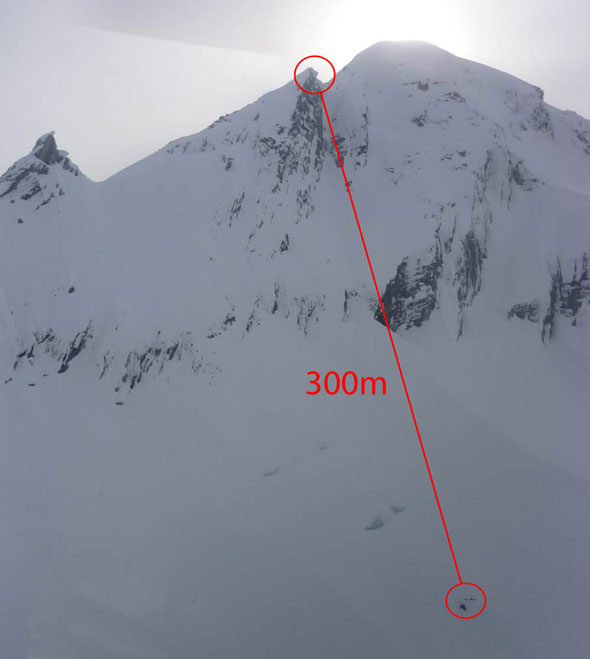
This is a view of the accident site on the North Face of Ursus Minor. The upper red circle indicates where the skier broke through the cornice; the lower red circle indicates where he stopped, 300m in total.
© Parks Canada
At this point the two remaining subjects had a short conference as to the best course of action. The only cell phone in the group was in the pocket of the fallen skier. It was decided for one person to travel back to the Roger’s Pass Info centre to raise the alarm, while the other was to try to find a way down to the victim to provide support and first aid. The skier heading for the info center made it back without incident by roughly 1400 hours.
The skier that was to assist his fallen comrade found a spot where he could access the steep face without the obstruction of a cornice. He then proceeded to descend the face which was between 45 and 50 degrees. After descending the steepest part of the face he skied onto the glacier and down to his injured partner where he provided first aid and tried to stabilize the scene, knowing that a rescue was coming.
Mountain Safety Programs Specialists responded with a helicopter rescue. After scene surveillance the crew was able to stage in a meadow below the glacier. Two rescuers were inserted into the accident sight via long line, where they packaged the injured skier to be transported directly to Rogers Pass and the waiting ambulance. One rescuer slung out with the patient directly to Rogers Pass while the second rescuer packed up the remaining gear. The helicopter came back to pick up the second rescuer and the injured skier's companion and deliver them back to the meadow where the crew originally staged from. From here they packed up the gear and flew back to Rogers Pass where the incident was wrapped up.
The fallen skier is expected to make a full recovery. The injuries were remarkably minor given it was a 300m+ fall.
Analysis
In an interview with one of the party members they reflected on two key points. The first was that cell phone reception is available at most locations pointing towards the Trans Canada Highway near Rogers Pass. It was hind sight that got them thinking it would be worth every member of the party carrying a cell phone with them, especially based on the weight/benefit ratio. Having a phone in this particular situation would have sped up the response by about 2 hours.
Secondly they described having a healthier respect for cornices. It is unknown whether the fallen skier fell through the cornice, or was levered off when the cornice itself fell. The take home message is: Pay extra attention while traveling along side cornices, and when you feel like you are at a safe distance from the edge take another step away to create some extra margin. This may compensate for an unusual occurrence. (For example the cornice breaking back onto flat ground)
Substantial Leader Fall, Cascade Waterfall, Banff National Park, Feb 13, 2010
A party of two was climbing the second to last pitch of Cascade falls. The belayer was off to the left side at a bolted station while the leader was climbing up the pitch placing ice screws. The leader placed approximately four ice screws on the 40m pitch and was nearing the next bolted station. The leader was climbing low angle terrain just below the bolted station when a piece of ice dislodged from the main waterfall and hit the lead climber, knocking his legs out. The piece of ice was described as the size of a beach ball. The lead climber subsequently fell the entire length of the pitch.
The fallen climber ended up just to the side of the belayer. The fallen climber’s partner tied him off, and self belayed with the free end of the rope. He was then able to pull the fallen climber into a bolted belay, which had a good ledge. At this point in time the partner called 911 and was transferred to Banff Park Dispatch, and reported the incident. Parks Canada Mountain Safety Specialists responded with a helicopter sling rescue staged from the Banff Air Strip below Cascade Waterfall. The first rescuer was inserted to the accident sight to assess situation, the second rescuer was inserted shortly after. After some re-adjustments of the anchor and clip in points, the patient was slung off with the first rescuer by his harness. The second rescuer was slung off with the patient’s partner after patient was delivered to Banff EMS.
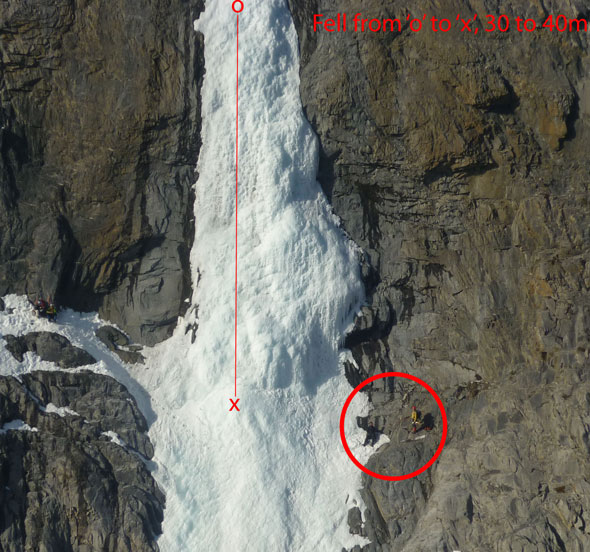
The injured person is in black, on the right of the waterfall. The photo was taken prior to the rescue during scene surveillance.
© Parks Canada
Analysis
The party chose a very warm day to climb Cascade, which has a SE aspect to begin with. Being mid February the sun had a significant effect on the ice quality and surface. This was likely the cause of the falling ice debris that caused the lead climber to fall. To compound the situation of season and aspect they were climbing late in the day (14:00 hours) in which the day time highs reach their maximum. This is not to say ice cannot fall in any circumstance, but aspect, time of year and time of day coupled with the daytime high (temp) is crucial information to remaining safe on waterfall ice climbs.
- Date modified :